Leasing space near retail outlets has become a bigger priority for office tenants that want to attract and retain talent or lure back remote workers. “The retail and food-and-beverage surrounding office has become a significant driver of desirability,” said Adam Showalter, managing director of Stream Realty Partners’ national office investor services. “It has become a major topic of conversation in the [site selection] decisionmaking process.”
More from C+CT
How Retail and Multifamily Work Together
How Retail and Hotel Work Together
How Retail and Industrial Work Together
Retailers, meanwhile, benefit from the return-to-work push by office occupiers. According to the Real Estate Board of New York and Placer.ai, total mobile device visits at 350 Manhattan office buildings this past July reached 15.2 million, a 10% year-over-year increase. Midtown Manhattan office visits that same month hit 80% of the 2019 pre-pandemic baseline, the organizations said, and A-plus properties rebounded to 93% of that prior benchmark.
MORE FROM C+CT: How Retail and Multifamily Work Together
The surge is driving restaurant and retail foot traffic across the Big Apple, said Javier Lezamiz, Cushman & Wakefield senior managing director of asset services for New York City and Long Island. “You can see it, just walking the [central business district] corridors in morning, lunchtime or even the evening rush.”
Office-Retail Hotspots
Smaller office occupiers, of 15,000 square feet or less, including tech start-ups, are among those that are most focused on lively settings with ample retail, Showalter said. The trend helps explain why mixed-use districts like East Austin in Texas, Fulton Market in Chicago, West Midtown in Atlanta and South End in Charlotte, North Carolina, boast “significantly outsized demand” for office space, the executive noted. “The majority of the time, these tenants have made a strategic, thoughtful research decision to move to a true mixed-use environment, whether it’s a West Midtown or a Fulton Market or a Wynwood/Design District in Miami,” Showalter said. “They narrow their search based on that decision.”
According to Cushman & Wakefield, office development in Charlotte’s South End from 2019 through the second quarter of 2024 totaled more than 3 million square feet, a 132.8% increase in overall inventory. Notable new mixed-use and Design District projects in South End include 110 East, The Line, Vantage South End and Lowe’s Design Center Tower. The average office rental rate for South End and Midtown hit a historical high in the second quarter at $46.81 per square foot, with the two areas’ combined Class A rates reaching $47.72. Those South End/Midtown rates were the highest of any submarket in Charlotte or the Carolinas, the firm said.
Talent Magnets
Stream Realty relocated its Chicago office to the Fulton Market District in part, Showalter said, because the mixed-use setting would help the national real estate firm better attract and retain young talent. The district is known for its historic, red-brick buildings and lineup of restaurants, bars, retail shops and luxury hotels, along with both corporate headquarters and “trophy” offices. “Fulton Market is the most active food-and-beverage submarket in all of Chicago,” Showalter said. “It has become a true live-work-play environment, which was conducive to the type of office location that we were looking for.”
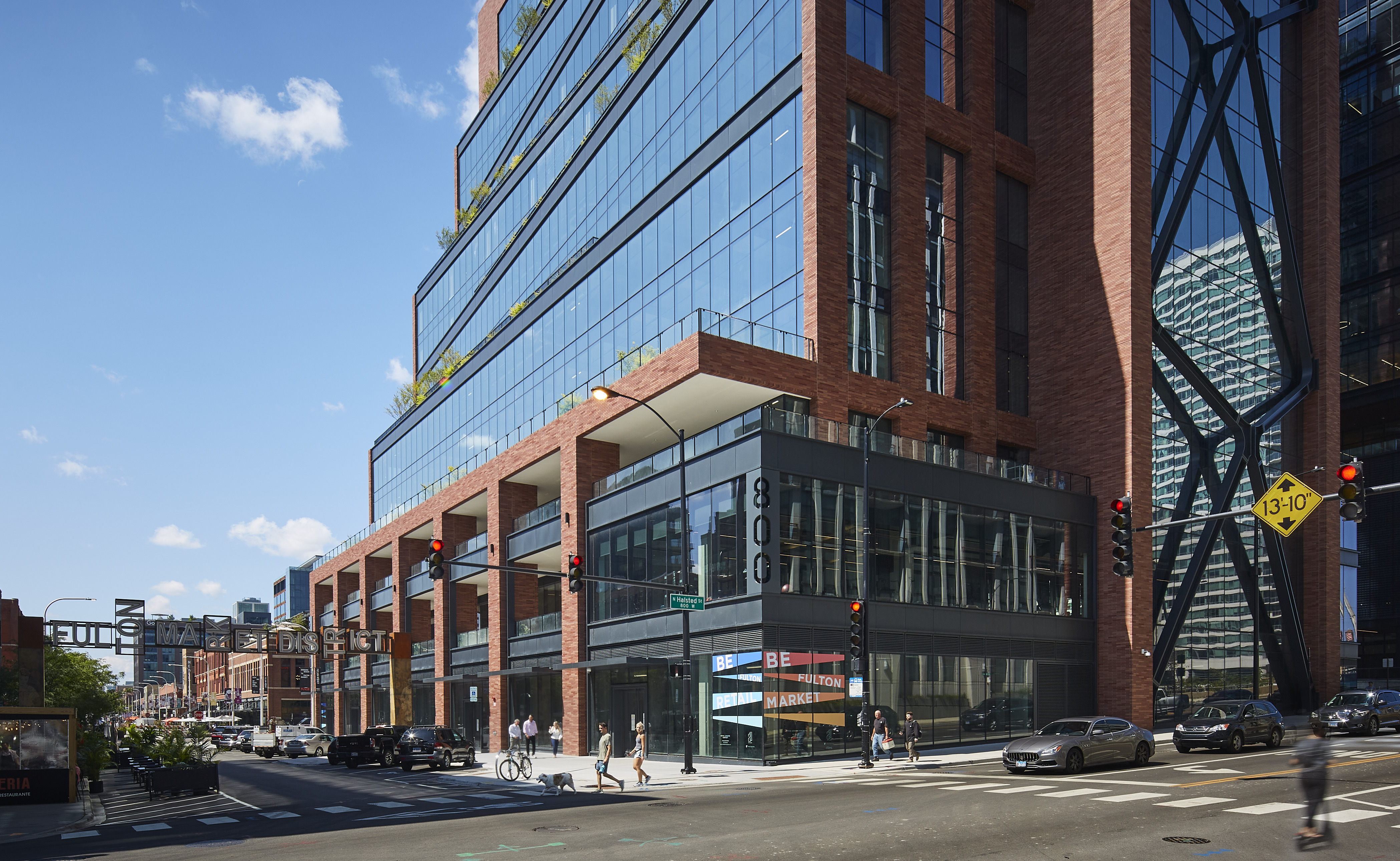
The Class A, 19-story, 800 Fulton Market stands at the gateway to Chicago’s retail- and restaurant-rich Fulton Market District. The vibrant area boasts higher office occupancy rates and rents due in part to the strong office-retail interaction. Photo credit: SOM, Dave Burk
In Cushman & Wakefield’s second-quarter office market report, researchers note that Fulton Market commands some of the Chicago CBD’s highest rental rates. The District’s average asking rent was $59.32 per square foot, with Class A reaching $69.85, by the end of the quarter. By comparison, the average asking rent for all office classes across downtown stood at $43.09 in the quarter. Fulton Market also posted a lower vacancy rate, 13.2%, than the broader CBD’s 25.2%.
The priority of appealing to young talent spurred Stream Realty to relocate its Atlanta operations to an office-retail hot spot, as well, in this case to The Interlock, Armada Hoffler’s mixed-use project in fast-growing West Midtown. “We found a development that had a lot of retail, as well as a hotel, attached to it,” Showalter said. “It checked multiple boxes for us.” Stream Realty also has brokered a deal for another office tenant to locate there. In August, it announced it had represented the manager of Encore, Georgia Tech’s 50,000-square-foot incubator space for start-ups there, in a lease with social media company Fanbase.
According to Cushman & Wakefield Atlanta, West Midtown’s population jumped 68% between 2010 and 2023, with residents between the ages of 25 and 34 making up the highest share of the population. From 2020 to the second quarter of 2024, direct asking rents grew 38.9% to $47.93 per square foot, researchers said.
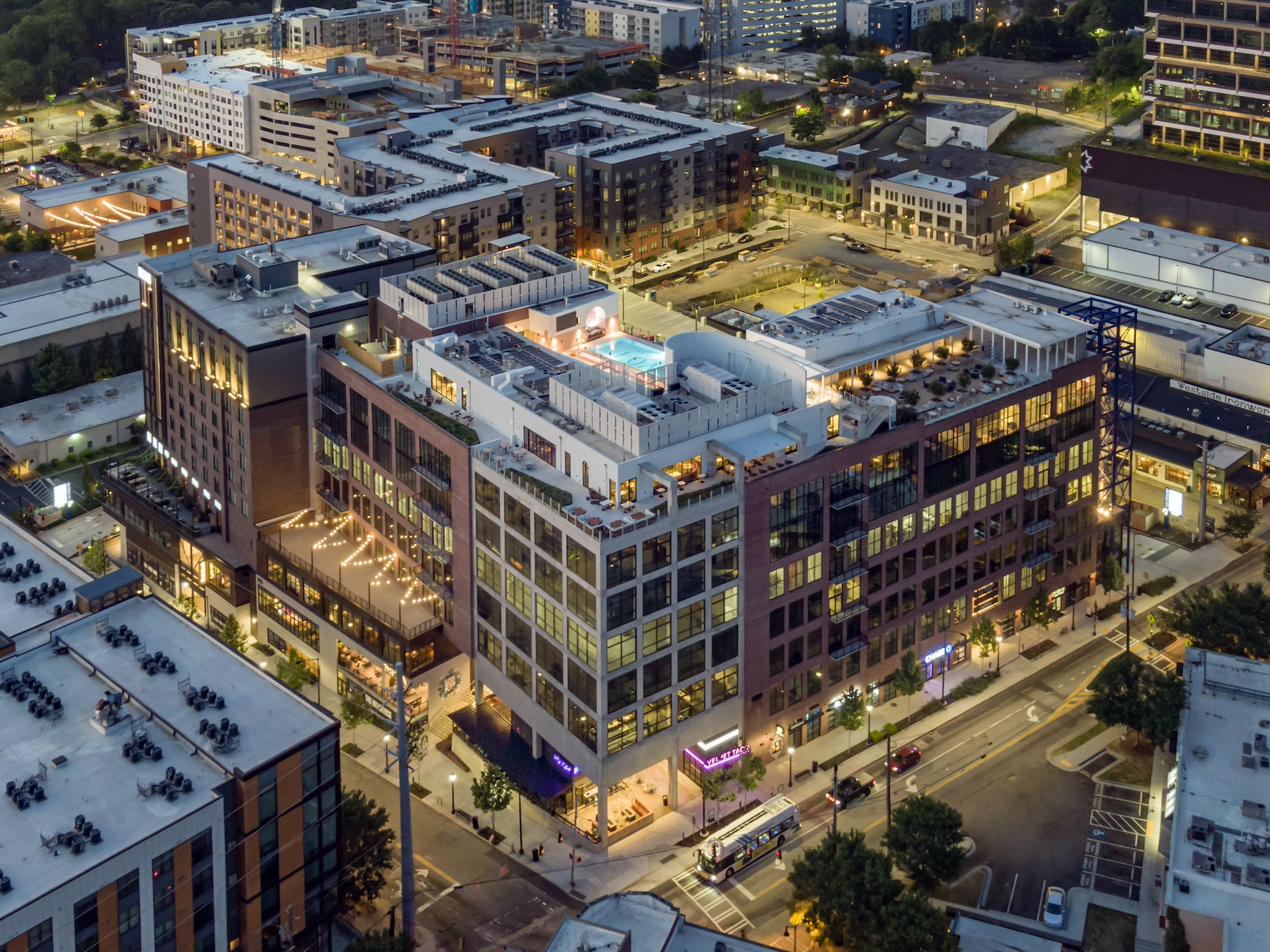
Retailers, restaurants and entertainment tenants have helped fuel higher office growth and performance in Atlanta’s West Midtown. According to Cushman & Wakefield, office sector direct asking rents in the district have jumped about 40% since 2020. Photo credit: The Interlock/Armada Hoffler
In addition to the Encore incubator space, The Interlock is home to 150,000 square feet of office tenants, such as Innovien Solutions and Destination Sport.
The Interlock’s 105,000 square feet of retail, entertainment and dining include Puttshack, The Escape Game, Sandbox VR, Velvet Taco and Pour Taproom. The nine-acre property also boasts 349 luxury apartments, a 161-room boutique hotel called Bellyard and a 38,000-square-foot “rooftop experience” with a pool, restaurants and outdoor gathering spaces overlooking West Midtown.

Now expanding nationally, Puttshack debuted at The Interlock in Atlanta, a West Midtown mixed-use project with 105,000 square feet of retail, entertainment and dining. Office tenants include Stream Realty Partners and Georgia Tech’s 50,000-square-foot Encore incubator space. Photo credit: Puttshack
Ad tech company DoubleVerify also was keen on proximity to retail and restaurants when scouting office locations post IPO, said architect Damian Besculides, senior principal and Americas head of client solutions at Unispace. While various New York office towers were an option, DoubleVerify moved into an older, timber-and-brick building at 28 Crosby St. in SoHo in the first quarter of 2023. The goal was to transition from a traditional workplace to an open and airy, post-pandemic “clubhouse” environment, with both collaborative and “heads down” workspaces. The retail-rich neighborhood was part of the site selection calculus. “They wanted their talent to be able to shop in SoHo during lunch breaks,” said Besculides, who was part of the Unispace team that worked on the project.
Office occupiers also can discover opportunities by locating near retail and mixed-use hubs. Strong development in and around a mixed-use district near Arizona State University in Tempe is part of what attracted global container shipping company MSC to open a Unispace-designed office there, Besculides said. “There’s a whole sector in development there to have shops, dining, retail and residential,” the architect explained. “It’s along the edge of the [ASU] campus and the [Salt River] that flows through Phoenix and Tempe.” Because ASU offers programs in supply chain management, logistics and sustainability, the location was perfect for MSC’s recruiting efforts. “They’re going to hire students directly out of the Carey School of Business,” he said. “Their idea is: Why try to attract talent from somewhere else when you can go to where the talent is?”
Traditional Office Persists
None of this is to suggest that traditional office site selection criteria no longer apply. Especially in gateway cities like Chicago, New York and San Francisco, larger occupiers like commercial banks, financial services firms and law firms continue to lease multifloor offices in corporate towers. “Here in Chicago, there are still millions of square feet of office space that tenants need and want on Wacker Drive, which is a traditional urban office market,” Showalter noted.
Lezamiz cited two Manhattan office buildings, both decades old, that Cushman & Wakefield manages: the 28-floor art deco 2 Park Ave. and the 50-floor 277 Park Ave. “These are 1 million- or 2 million-square-foot buildings that are basically high-rise cities,” Lezamiz said. Keeping tenants happy in these settings requires in-building amenities, not just proximity to neighborhood shopping and dining, he noted. “You have to provide amenities like outdoor spaces where they can go out and have a collaborative meeting, eat lunch or just sit and write emails.”
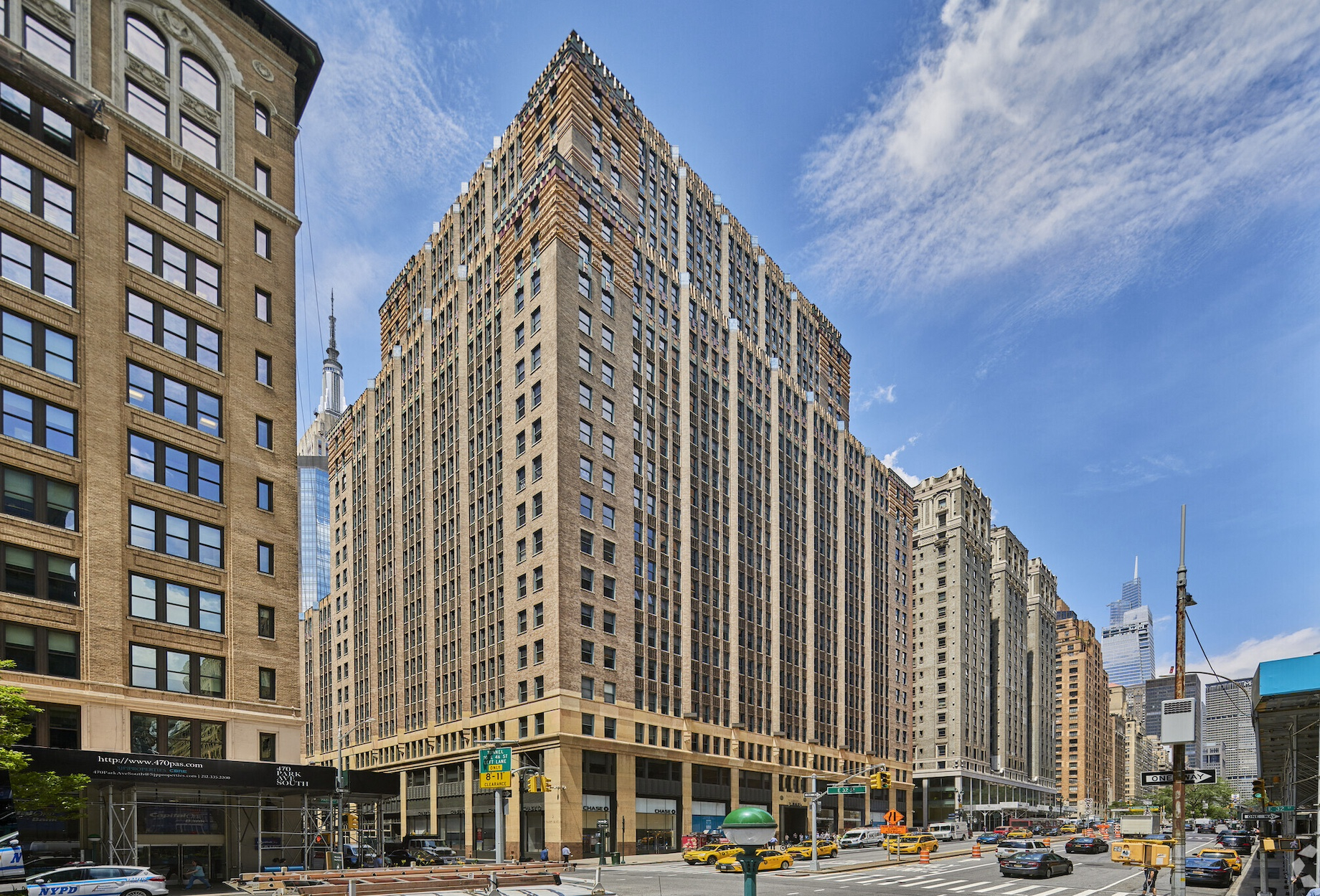
Massive buildings like 2 Park Ave. in Manhattan can be mini cities unto themselves, said Cushman & Wakefield’s Javier Lezamiz. “We try to bring under one roof a lot of what folks are looking for so that it’s just an elevator ride away.” Courtesy of Cushman & Wakefield
To put daily needs within reach, large office towers might lease ground-floor space to coffee concepts or tap third parties to run food-and-beverage outlets for the building. At 2 Park Ave., for example, the Ely Lounge and Terrace occupies the entire 27th floor, boasting a coffee shop, a wet bar, various lounge areas and a 2,300-square-foot outdoor terrace. “It’s important to make sure that the food-and-beverage component is competitive and affordable,” Lezamiz said. “Some office workers are on a budget.”
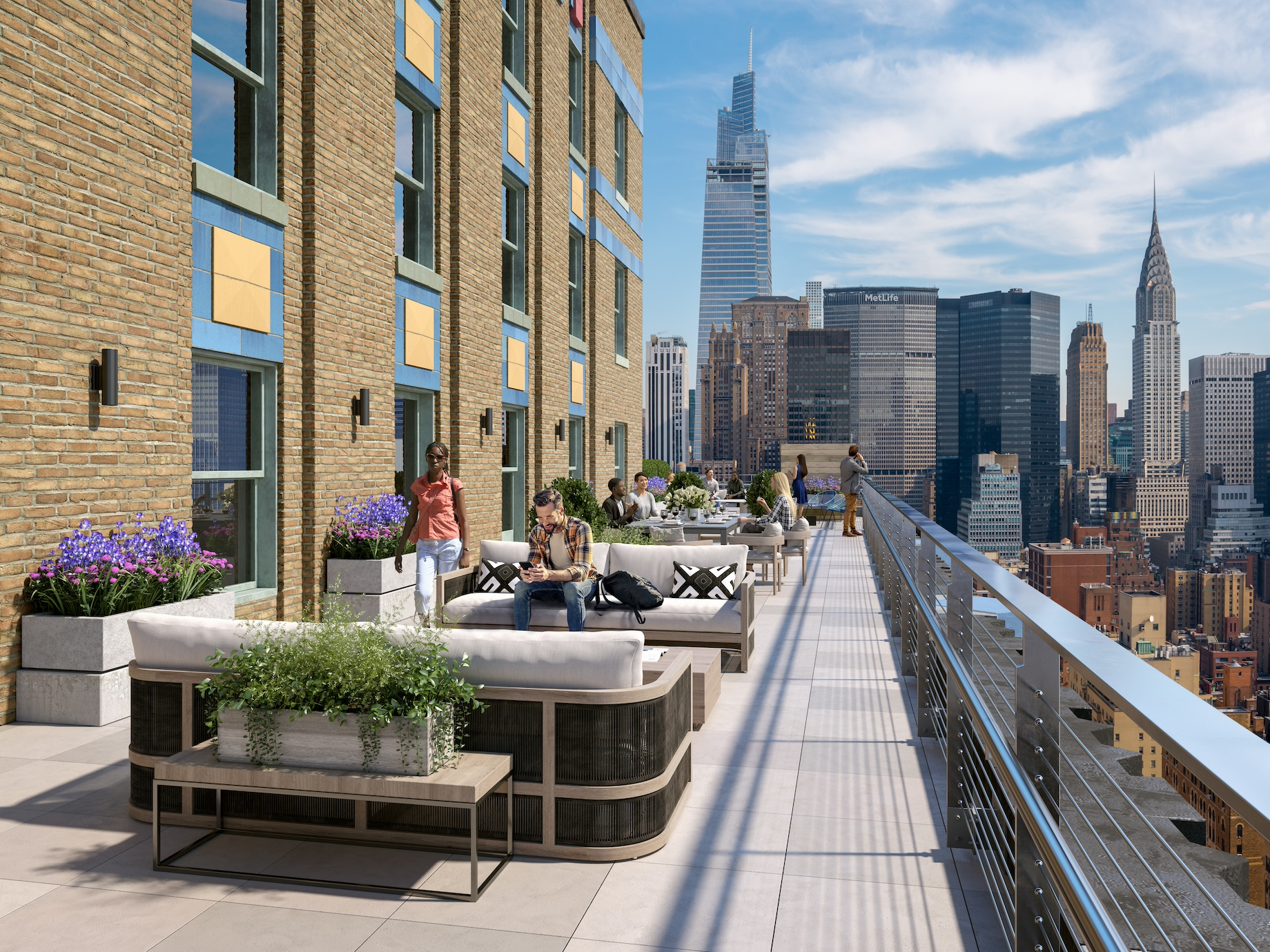
Ely Lounge and Terrace occupies the entire 27th floor of 2 Park Ave. Among its offerings are this 2,300-square-foot outdoor terrace. Food-and-beverage and outdoor spaces are important amenities for office tenants and their employees, said Cushman & Wakefield’s Javier Lezamiz. Courtesy of Cushman & Wakefield
Time is another key consideration, as most workers still have just an hour for lunch. “We try to bring under one roof a lot of what folks are looking for so that it’s just an elevator ride away,” Lezamiz explained. “You want to avoid people having to go out and worry about timing and returning back to the office.”
Still, some traditional, large office tenants do opt for retail-heavy, mixed-use environments. Showalter pointed to the broad-based office demand at Related and Oxford’s Hudson Yards on Manhattan’s West Side. “They created a neighborhood out of a shipping yard, in large part through the activation of retail,” Showalter said. “They were able to lease tens of millions of square feet to traditional and nontraditional tenants alike, with even higher rents than Park Avenue.”
Suburban Office-Retail Outposts
Demand is growing for retail-oriented office environments in U.S. suburbs, as well, Besculides noted. In some cases, companies shrink their pricey downtown offices in favor of multiple, smaller leaseholds farther out. “They’re bringing those smaller offices to their employees so that they can still have client meetings and collaborate in person,” the architect said. “If the company is in Manhattan, it might put 5,000-square-foot outposts in places like Long Island; Westchester [County, New York]; Greenwich, Connecticut; and Morristown, New Jersey. Suburban outposts allow you to reduce that rent roll by half or more.”
Those new offices might be filled with love seats, sofas, recliners, coffee tables and other furniture offering a homey feel, an office trend dubbed “resimmercial,” Besculides said.
In some cases, these suburban offices are located in mixed-use conversions of older buildings and office parks. One example is Bell Works, the 2 million-square-foot redevelopment of the former Bell Labs in Holmdel, New Jersey. Developer Ralph Zucker acquired the property in 2013 and teamed with architect Alexander Gorlin to modernize it, welcoming the first new tenant to the updated surroundings in 2016.
According to a spokesperson for Zucker’s Inspired by Somerset Development, the property is 98% leased. The likes of Mezza Luna, Bar Bella, F45 Training, Escapology and Velvet boutique form its retail lineup. Office tenants include Guardian life insurance, Nvidia, Cisco, Verisk, iCIMS and Jersey Central Power & Light. Bell Works’ offices range from fully built spaces of 6,000 to 100,000 square feet to “ready-to-wear” suites from 500 to 5,000 square feet. The property also offers a coworking space called CoLab.

Bell Works in Holmdel, New Jersey, is the 2 million-square-foot, mixed-use makeover of historic Bell Labs. Its retail lineup and suburban location are part of the attraction for office tenants and their employees. Photo credit: Bell Works
“They built an entire community, or ‘metroburb,’ around that formerly vacated building,” Besculides said. “When I’m not in [Manhattan] or traveling, I'll go there and work. We’re seeing more examples like this, where suburban corporate parks get turned into mixed-use with housing, retail and office components.”
The tighter relationship between office and retail also highlights the need for cooperation across commercial real estate property types as early as possible in project planning, Lezamiz said. Brokers from multiple sectors, for example, can help developers and architects make sure properties are rightsized. “Collaboration from Day 1 is crucial for any sort of buildout, whether it be for a tenant’s world headquarters or a developer’s ground-up, Class A, trophy asset.”
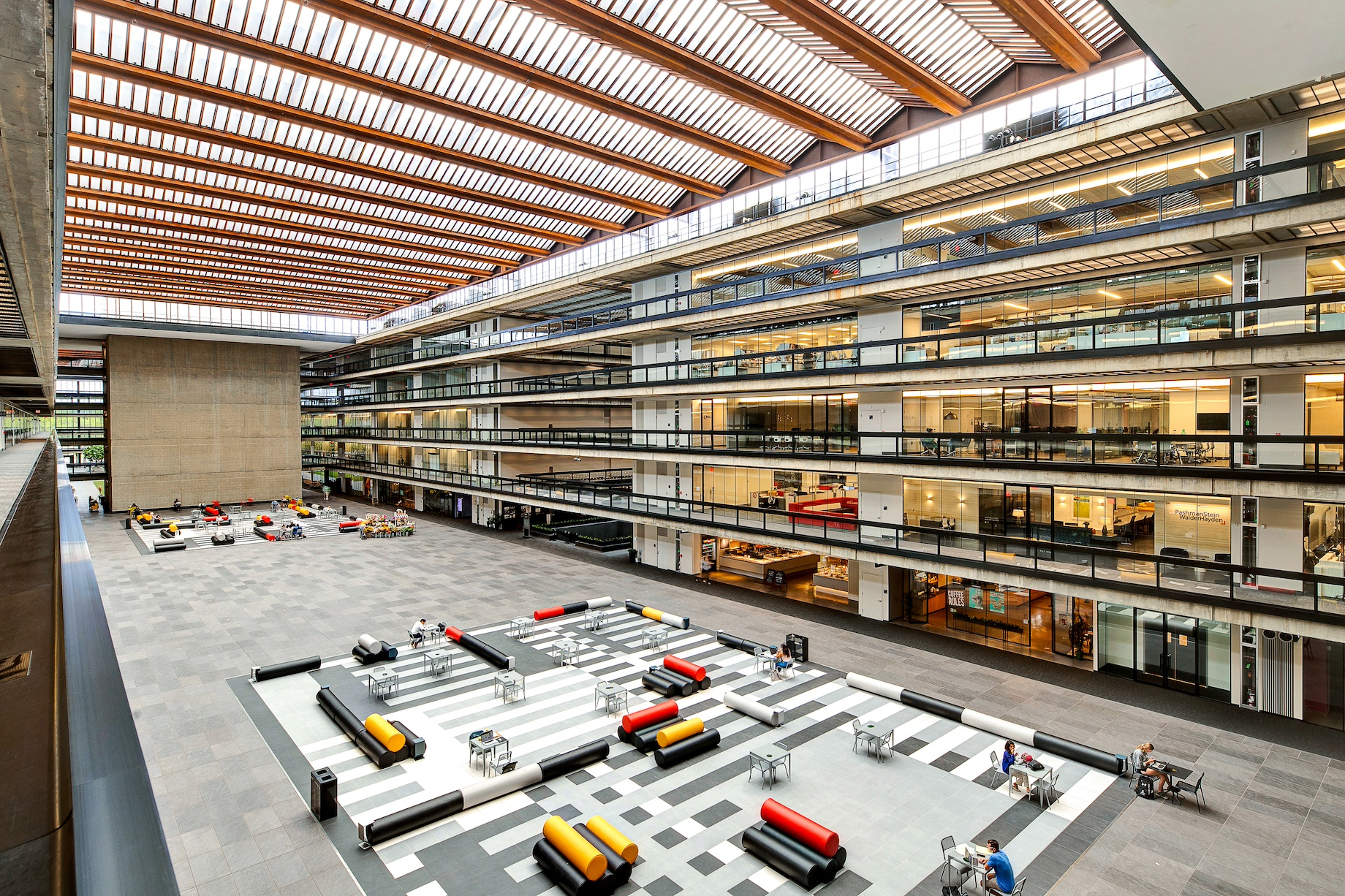
Massive spaces at Bell Works create an engaging experience for office workers and those who visit the property to co-work, eat or shop. Photo credit: Bell Works
By Joel Groover
Contributor, Commerce + Communities Today